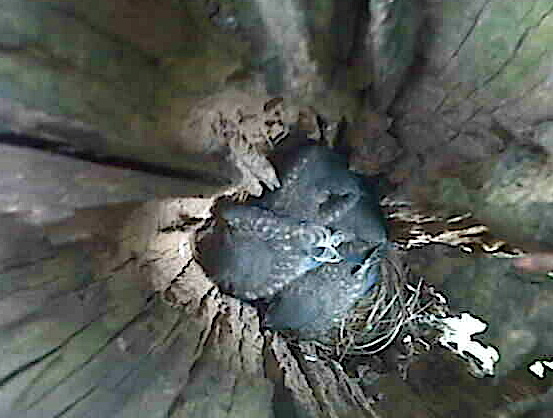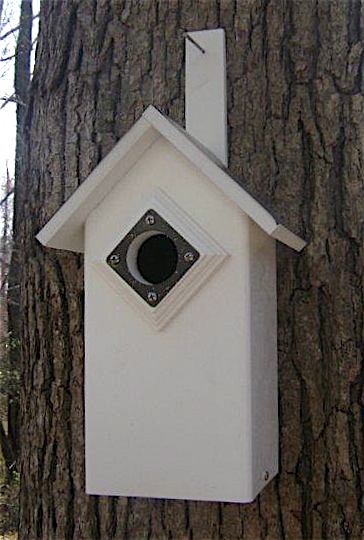-
blue bird houses vacant?
Using recycled materials greatly helps the environment by reducing waste and keeping said materials out of landfills. It takes about 25 to 40 plastic milk jugs to produce a recycled bird house or feeder. These blue bird houses are NABS approved, (North American Bluebird Society) and create the perfect nesting site for Eastern Bluebirds. With such a large shortage of natural nesting cavities, why would a great nest site like this be vacant?
Several factors will deem successful habitat for birds, and pesticides are detrimental in successful clutches. Environment plays the biggest role in attracting birds, and while everything may be super green and manicured in your yard, it may not be good for your avian friends. Ingested through insects fed by adults, pesticides wreak havoc on developing nestlings. Although sometimes not harmful to the adults, they are deadly to nestlings. If clutches in an area repeatedly fail, the bluebirds are likely to abandon the spot and seek other habitat.
Predators will also discourage nesting. Roaming cats, raccoons, snakes and larger bully birds will drive bluebirds from a possible nest site. House Sparrows and Starlings (both non-native species) will kill adult bluebirds in the nest box, as well as nestlings, and even destroy eggs too. Unfortunately this is common practice. These invasive and destructive birds are likely the main cause for the bluebird’s demise in the 70’s and 80’s. Ever-shrinking natural habitat with fierce competition for available nest sites being the reason.
•Be sure that blue bird houses are erected in proper habitat. Open spaces are preferred, with perching spots for hunting insects.
•Predator guards on bluebird houses also increase chances of successful fledging.
•Keep roaming cats indoors, or ask your neighbor to keep their cat out of your yard.
•Fresh water will entice bluebirds and others.
•Remove old nests (away from the area) after birds have fledged. A blue bird house with an old nest will not be used by another pair of bluebirds seeking a nest box.
•Supplemental feeding (with live mealworms) helps parents raise their young.
•Absolutely… quit the pesticides.
-
bluebird houses and turf wars
Is it possible to have too many bluebird houses? The answer would be yes and no, depending on several factors and just how “into” bluebirds you’re willing to get. I recently joined a forum for Bluebird Monitors as I’ve seen some pretty bizarre happenings with bluebirds this season.
In the past, Eastern Bluebirds have over-wintered in our North Georgia Yard, and have gone on to nest in various bluebird houses, raising several successful broods. It’s awesome to watch older siblings help raise the fledgelings too. And mom and dad will work as a pair for about 30 days to raise their brood.
The first five eggs all hatched, all fledged… off to a good start, right? Not really 🙁 The male disappeared about 3 days before these babies fledged, so mom was on her own. It wasn’t long before these babies learned to feed themselves at the mealworm feeder. Granted, only three of them made it thus far, but it looked promising. I then noticed a strange lump, almost a protrusion on one of these babies, which was the reason for joining the bluebird forum. After posting the question, I’d received a detailed answer saying this was likely a broken air sac, which happens frequently to fledgeling as they can’t really tell yet what’s solid or open. It could either absorb itself, or turn infectious. I watched daily, this group of three siblings who stuck together at feeding times. It was the female with injury and I so hoped she remain okay. And she did for a while, until the turf wars began.
Enter a new male Eastern Bluebird: he had it in for these fledgelings as they were not his brood. Relentlessly he’d chase them from feeder to feeder, dive-bombing and harassing them constantly. It was the most difficult thing to watch. The new male was trying to attract one of the two adult females… and with all his might at that. One day there were no fledgelings, two days and no fledgelings, by day three I’d given up. The male had either driven them from the area, or killed them. I’d never seen Bluebirds engage in such behavior, and it saddened me.
About one week later, I learned of the new nest and the babies who had hatched. Never actually monitoring this bluebird house, I’d watch the female cram as many worms in her mouth as she could and fly to the box, so I knew she was feeding hatchlings. This bluebird house sits very high up, so again, it was never monitored. The ot
her day I saw both parent bring three fledgeling to the mealworm feeder, and had better hopes for a successful brood.
Typically Bluebird Houses should be about 100 feet apart. With an acre of land, we have several different kinds of houses for them. Other cavity nesters also use bluebird houses and this is where some extreme bird wars are created. House Sparrows are enemy number one, destructive and aggressive, they’ll chuck Bluebird eggs from the houses, kill nestlings, and even adult Bluebirds. House Wrens will do the same, wreaking havoc on Bluebirds. Tree Swallows will also compete for Bluebird Houses, and sometimes adding a second house 10-15 feet apart helps eliminate competition. After reading the many posts from the Bluebirds Forum, I’ve learned that most species are quite territorial during nesting season, aggressive and downright mean. Predator guards help some, and devices called “sparrow spookers” may keep these non-native demons at bay, but I guess it’s just survival of the fittest, kinda sad that mother nature can be so tough.
-
some cool blue bird houses to last a lifetime
baby bluebirds grow up in a fence post at the farm With a severe shortage in natural nesting places, bluebirds will appreciate decent diggs to nest and raise their young. With increasing development from strip malls to subdivisions snuffing out habitat, competition from non-native species also plays a huge part in this shortage of nest spots.
You can provide proper housing in high style, with blue bird houses that will never rot, fade or warp with weather and time. More than just wood, materials like vinyl, ceramics and stoneware make for fantastic blue bird houses that are handcrafted to last a lifetime. This Vinyl Cottage Bluebird House happens to be NABS (North American Bluebird Society) approved. Complete with a metal predator guard, it helps protect eggs and nestlings from predators like cats, raccoons, and larger birds.
On a more artistic note, handcrafted stoneware blue bird houses can provide an interesting focal point in the landscape, while providing a proper nest site for blue birds. Stoneware is also inert, meaning it will not rot, is totally insect proof and guarantees to be around for a lifetime.
Help bluebirds thrive and flourish by erecting blue bird houses in your yard. You can entice them with suet and heated birdbaths in winter, and of course their favorite food any time of year… live mealworms! If you’re lucky enough to have more than one successful brood, it’s a real joy and pleasure to watch juveniles from the first brood help raise the new chicks and teach them to hunt.






